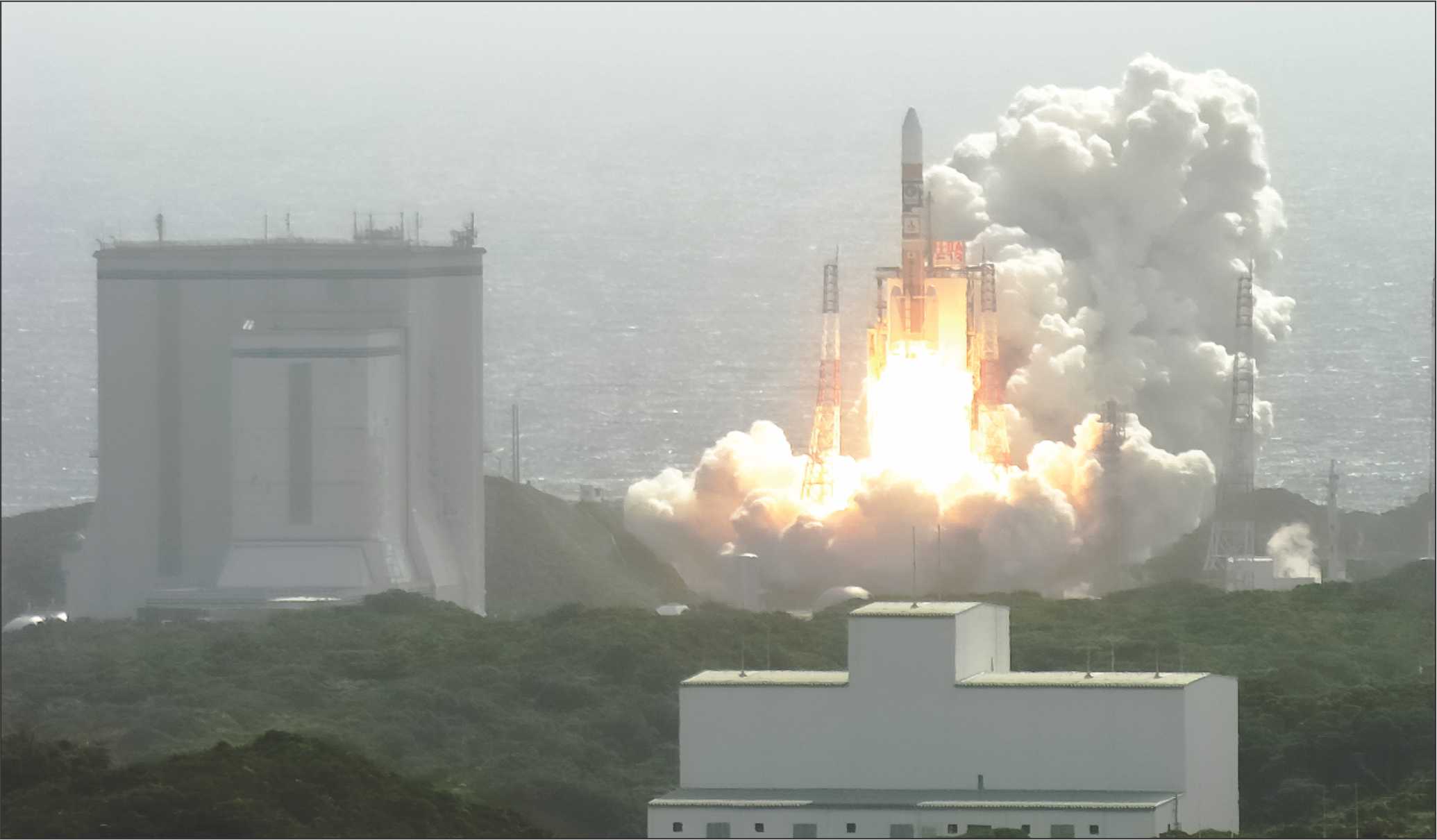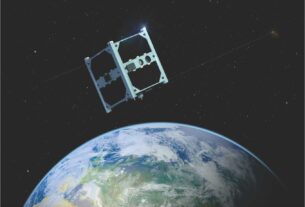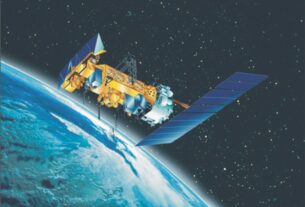Notwithstanding the tremendous strides made by Japan in the frontiers areas of scientific research and cutting edge futuristic technology, the island nation is yet to leave its imprint on the multi billion dollar global market for launching satellites of various categories on commercial terms.
While the two other Asian space faring nations, India and China, are making steady progress in attracting customers-mainly from the third world countries-for their commercial launch service, Japan seems to be lagging behind in the critical area of space launch business.
And in a landmark decision aimed at turning the Japanese space program into an economically viable enterprise, considered a vital step towards making Japan a competitive player in the fierily competitive but lucrative global space market, the Japanese space agency JAXA (Japan Aerospace Exploration Agency) has been freed from the responsibility of the launch operations of country’s heavy lift H-IIB rocket.
Consequently, Mitsubishi Heavy Industries (MHI), which has been handling the launch of H-II A since 2007, will also be responsible for H-IIB launches. This was sequel to the successful July 2012 launch of the H-IIB vehicle which placed into low earth orbit Kounotori 3, a cargo transfer vehicle for facilitating supply runs to the International Space Station (ISS).
H-IIB, an upgraded version of H-IIA, is capable of carrying an eight tonne class satellite payload into a geostationary transfer orbit. The objectives of H-IIB are two fold-to launch supply vehicles to ISS and respond to the expanding and diversified launch needs by combining the potentials of H-IIA and H-II B rockets. H-IIB’s heavy lift capacity will make it possible to perform a simultaneous launch of more than one satellite and in the process help reduce the overall launch cost. This is expected to make a contribution to the strengthening of Japanese space industry in a big way. The H-IIA rocket was initially designed and built as a government project in which Mitsubishi Heavy Industries (MHI) took part. It has been privatized as a business of MHI.
Making contribution
Meanwhile, the successful launch of Japan’s newest rocket, Epsilon in 2013, after its previous aborted mission, has raised the hope that the country may eventually be able to enter the multi- billion dollar global market for satellite launchings. For Epsilon is meant to reduce the launch cost to make its services affordable to customers.
Incidentally, Japan has long been one of the world’s leading space power having launched its first satellite way back in 1970. However, it has not been able to catch up with China which in recent years has pulled off a series of space spectaculars as a prelude to realizing its own space orbiting laboratory by the end of this decade. What’s more, on account of the high cost of its space program, Japan has not been able to get a foothold in the global satellite launch business currently dominated by Russia, US and Europe. By gaining a foothold in the global business of launching satellites, Japan can expect to expand its diplomatic and commercial clout in a big way.
Against this backdrop, JAXA is optimistic that the privatization of H IIB launches could result in the lower production and operating cost and help this island nation establish its toehold in the global space market. On its part, JAXA points out that “It would like to engage in enhancing reliability as well as maintaining and operating Japan’s launch facilities in order to provide reliable launch services to meet the broader demands.” Not to be left behind, MHI is quite optimistic about working towards the export of “space infrastructure to emerging nations as a package with the satellite launch services at the core.” According to MHI, it intends to strengthen global competitiveness in this business through continuous cost reduction and quality enhancement activities.
Clearly and apparently, MHI seems to be looking at China, which has quietly and efficiently entered the global market for launch services, by offering satellite development and its launch in a single attractive package for a number of third world countries, for the lead in so far as promoting Japan’s launch service in the global space market is concerned.
But for the moment, none can deny the reality that the high cost of Japanese launch vehicles is driving Japanese satellite operators look for launch support elsewhere. For instance, Japan’s leading commercial satellite operator, SkyPerfect JSAT Holdings Inc, has clinched an ambitious deal with the European space transportation company, Arianespace, for the launch of a few unspecified future satellites. The European Ariane -5 vehicle has emerged as the most sought after and reliable launch vehicle for orbiting satellites on commercial terms. A large number of communications satellites in INSAT/GSAT series being designed and developed by the Indian Space Research Organisation(ISRO) are launched by means of Ariane-5 on commercial terms.
Entering business
Of course, with the May 18, 2012 flawless launch of 800-kg Kompsat-3 South Korean earth observation satellite, as one of the four payloads on- board the H-IIA vehicle, Japan gave the world notice that it has taken a modest step towards making its presence felt in the global business for launching satellites. But then Japan would need to keep up its tempo of launching satellites of “emerging nations” on commercial terms to break the entry barriers associated with the global launch services market. As space business analysts point out, this launch represents Japan’s first foray into the rapidly expanding satellite launch service business. The liquid fuel driven H-II series of launch vehicles that would serve as Japan’s space workhorse mirrors Tokyo’s determination to free itself from imported launch vehicle technology. For the earlier generation N-1 ad N-11 launch vehicles used during 1970s and 1980s contained 70% of US made components. .
Tipped as Japan’s most successful launch vehicle, the H-IIA rocket has logged 95% success rate. Japanese Industrial major MHI, has been the prime contractor for launch services and manufacturer of the rocket since 2007 when launch vehicle development in the country was fully privatized. MHI is optimistic that this landmark launch of commercial significance will attract more international customers as the domestic launch business has been limited almost exclusively to government orders.
MHI claims that it has covered a substantial ground in reducing the launch vehicle cost even as the nation’s high cost for labour and materials continue to mar the competitiveness of Japanese space industrial sector. By all means, cost factor will have a major impact on the Japanese space launch service in so far attracting global customers for satellite launches is concerned.
Another major factor that would weigh down heavily on the Japanese space program would be the rapidly aging population of the country. Indeed, securing the support of talented young manpower to drive the space program would be a worrying factor for the country in the years ahead.
To bring down the overall production cost of H-II vehicle, MHI plans to streamline the production facilities by falling back on the advanced computer technology from the aviation industry. Aerospace industry analysts point out that like other players in the arena of global satellite launch business, Japan should consider offering a package deal that involves the ground tracking and in-orbit management of the satellite of the customer till such time as it becomes fully operational. Unlike Indian and Chinese launch vehicles, which are government funded and cost efficient due to low labour cost, Japanese H-II series vehicles continue to be a stiffly priced launchers.
Of course, Japanese space industry captains are fully well aware that the time is now opportune to grab a share of the fast expanding global space market. With an increasing number of countries from across the world showing more than usual interest in entering “satellite era”, Japanese space industry can definitely look forward to make it big in the global space market. Some industry experts hold the view that Japan is entering the satellite launch business more for national prestige than for profit. As it is, the Japanese Government continues to fund satellite development by the Japanese companies despite the fact that they cost more than satellites of similar capability and performance offered by the front ranking global aerospace companies.
In the meantime, Japan is on the job of amending its pacifist constitution with a view to harness its strides in space in support of its strategic goals. Indeed, North Korea’s sabre rattling with its plan for long range missiles and China’s growing assertiveness have meant Japan would be interested more in the military applications of its space program rather than exploiting its commercial potentials. Looking into the future, the biggest limiting factor perhaps for Japan will be the human capital as the Japanese cadre of scientists and engineers that constitute the space workforce diminish further in the face of changing demographic scenario.
Meanwhile, JAXA wants to put in place a rocket that will achieve a significant presence in the global market for launching satellites on commercial terms. This launch vehicle will be designed to leverage state of the art technologies to reduce cost and boost efficiency.
Diplomatic tool
On the other hand, China has been able to pull off some degree of success in satellite launch business due to a strong support from the Government as well as a robust human resources base giving a resurgent lead to its space programme. For China, its expanding footprints over the global space market is a means to boost its “influence and clout” in the community of nations in addition to improving the bottom-line of its domestic aerospace industry. China also considers space technology as a platform to project its ‘soft power” and further its “diplomatic interests” across the globe.
In a development of significance, China will help Sri Lanka launch its first exclusive satellite SupremeSAT-II by 2016. SupremeSAT,the Colombo based Sri Lankan enterprise responsible for this satellite system, says that it has reached an agreement with Sri Lankan Board of Investment for US$20-million for the project. SupremeSAT has already clinched a deal with the state owned China Great Wall Industry Corporation (CGWIC) for the design, production as well as the launch of SupremeSATII.
In November 2012, Sri Lanka’s first co branded SupremeSAT-1 satellite was put into orbit at the head of the Chinese Long March CZ-3B/E vehicle. CGWIC is business arm of the Chinese space program, providing satellites and launch services on commercial terms and carrying out international space cooperation. In August 2011, China had launched Pakistan’s first communications satellite ,Paksat-1R by deploying its Long March-3B vehicle. The satellite with its 30 transponders is meant for broadband, telecom and broadcasting services. China is also looking at building and launching a domestic satellite system for Maldives. Bangladesh and Nepal too are on the radar of CGWIC.
Chinese commercial space venture has made significant inroads in Latin America. Bolivia’s first telecommunications satellite named Tupac Katari was launched in December 2013 at the head of a Chinese Long March-3 vehicle. Ivan Zambrana, chief of the Bolivian space agency has described China as a “world class space power”. Evidently, South America has a strategic importance for China because of its physical proximity to the USA. In 2008, Beijing launched Venezuela’s first satellite Venesat. In September 2012, China launched Venezuela’s second satellite. This spacecraft named Miranda was meant for earth observation applications. As a follow on to this, the China Aerospace Science and Technology Corporation (CASC) has signed an agreement with Venezuela for the in orbit delivery of Venezuela’s second remote sensing satellite.
China has also forged a strong space ties with Brazil. Under China Brazil Earth Resources Satellite Program (CBERS) a series of earth observation satellites are being developed and launched. In December 2013, the Long March-4B Chinese rocket had failed to deliver into orbit CBERS-3 which was a part of CBERS. The CBERS-3 was the fourth satellite to be orbited under the China-Brazil cooperation programme. Three satellites-CBERS-1, CBERS-2 and CBERS-2B- are already in orbit. It is now planned to launch CBERS-4 sometime towards the close of this year. China and Brazil have also decided to cooperate in building CBERS-5 satellite and its launch in 2017.
Marking its foray in the African continent, in 2011, China successfully launched a Nigerian communications satellite Nigcomsat-1R by means of a Long March-3B carrier. This satellite is designed to provide communications, broadcast, internet communications and navigation services.
China will also build and launch a communications satellite for Laos by 2015. As part of the agreement, China will build a ground control station in the capital city of Vientiane and tracking and transmission stations in other parts of this South East Asian country. China and Laos have also signed a Memorandum of Understanding for cooperation in the construction of a satellite communications industrial park in Laos which is claimed to be the biggest in ASEAN (Association of South East Asian Nations).
Promoting soft power
Like China, India too is promoting its soft power by making available its space expertise including launch service to the international customers. The June 30 successful orbital mission of the Indian space workhorse Polar Satellite Launch Vehicle (PSLV) which was witnessed by the Indian Prime Minister Narendra Modi involved the launch of as many as five satellites belonging to overseas customers at one go.
According to K Radhakrishnan, Chairman, Indian Space Research Organisation (ISRO) this was the third dedicated commercial mission of PSLV since it started offering the services of launching satellites of foreign customers for a fee beginning May 1999. This PSLV mission which happened to be the 26th consecutive successful flight of this reliable and versatile space vehicle put into orbit as many as five satellites in one go, in less than twenty minutes of the take off. The 714-kg Spot-7 earth observation satellite of France was launched as the primary payload. The four other satellites that were orbited as piggyback payloads were: 14-kg AISAT of Germany, 7-kg Velox-1 Singapore and NLS 7.1 and NLS 7.2 Canadian satellites weighing 15-kg each.
With the successful accomplishment of June 30 mission, as many as 40 satellites belonging to international customers from countries such as Algeria, Italy, Israel, Luxembourg, Belgium, Germany, Indonesia, Canada, Singapore, Switzerland and South Korea have been delivered into orbit by PSLV. According to Bangalore based Antrix Corp, the commercial arm of the Indian space program, the continued successful track record of PSLV has led the customers reiterating their confidence in PSLV. As such Antrix is confidentially forging ahead with the mission to promote PSLV as a cost efficient and reliable space vehicle for small and medium class satellites destined for low earth and medium earth orbits.
With the early 2014 successful debut flight of India’s three stage Geosynchronous Satellite Launch Vehicle (GSLV) carrying a fully Indian made upper cryogenic engine stage, Antrix can now look forward to expand its launch service portfolio by introducing GSLV for launching two tonne plus class satellites into the geostationary transfer orbit.
Of course, before GSLV services are offered for launching satellites of foreign customers, the vehicle would need to go through a couple of successful developmental flights. And beyond GSLV, Antrix can also look ahead at offering the services of high capability three stage GSLV-MK III whose experimental flight is planned to take place sometime this year. The 630-tonne GSLV-MKIII can carry a 4-tonne class satellite payload into a geostationary transfer orbit.
Sometime during the second half of this decade, a PSLV commercial mission will launch the heaviest ever satellite-800kg plus German hyper-spectral environmental mapping mission. On another front, Antrix Corp, has entered into lunch services agreement with DMC International Imaging (DMCII), the wholly owned subsidiary of Surrey Satellite Technology Ltd of UK ,for the launch of its three DMC-3 earth observation satellites by means of PSLV. Further, Antrix has signed launch services agreement with ST Electronics (Satcoms and Sensor Systems) Pte Ltd of Singapore for launching its TeLEOS-1 remote sensing satellite by means of a PSLV flight. Antrix sources said that these launches are planned to take place during 2014-15 timeframe.
There are, of course, many entry barriers that Antrix may have to face when it comes to launching heavier class commercial satellites. For the satellites built in US and satellites carrying US origin hardware are not allowed to be launched by a space vehicle of another country under the US export regulation. Because of the US export regulations, Antrix had lost two potential commercial orders for launching satellites.





